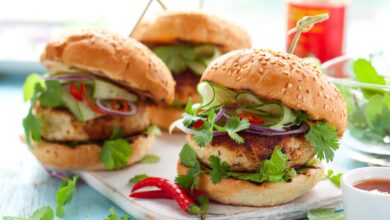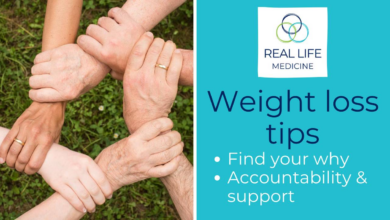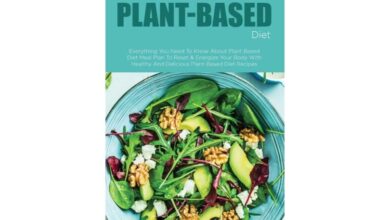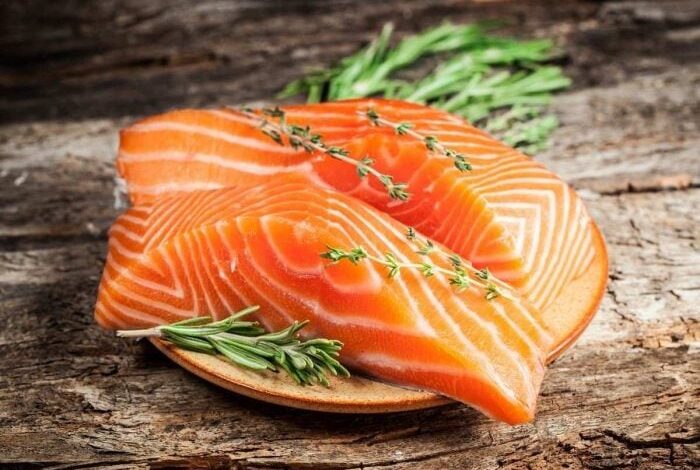
Fit Food Spotlight: Salmon, Your New Health Hero
Fit food spotlight salmon – Fit Food Spotlight: Salmon, Your New Health Hero, dives into the world of this nutritional powerhouse. Salmon isn’t just a delicious fish; it’s a true champion for your health. From its omega-3 fatty acids to its impressive protein content, salmon offers a wealth of benefits for your body and mind.
We’ll explore its nutritional profile, delicious recipes, and how to incorporate it into a healthy lifestyle.
Whether you’re looking to boost your brainpower, strengthen your heart, or simply add more flavor to your meals, salmon has something to offer. We’ll cover the best ways to cook it, sustainable practices, and even delve into its cultural significance around the world.
Salmon Nutrition Spotlight
Salmon is a popular and nutritious fish that offers a wide range of health benefits. Its rich nutritional profile makes it a valuable addition to any diet.
Nutritional Benefits of Salmon
Salmon is a rich source of essential nutrients, including omega-3 fatty acids, protein, and vitamins.
- Omega-3 Fatty Acids:Salmon is an excellent source of omega-3 fatty acids, particularly eicosapentaenoic acid (EPA) and docosahexaenoic acid (DHA). These fatty acids are crucial for heart health, brain function, and reducing inflammation. They have been linked to a lower risk of heart disease, stroke, and depression.
- Protein:Salmon is a high-quality protein source, providing all the essential amino acids your body needs. Protein is vital for building and repairing tissues, maintaining muscle mass, and supporting a healthy immune system.
- Vitamins:Salmon is a good source of several vitamins, including vitamin D, which is essential for bone health, vitamin B12, which is important for nerve function, and vitamin A, which is crucial for vision and immune function.
Wild-Caught vs. Farmed Salmon
There are significant differences in the nutritional profiles of wild-caught and farmed salmon.
- Omega-3 Fatty Acids:Wild-caught salmon typically has higher levels of omega-3 fatty acids than farmed salmon. This is because wild salmon have a more diverse diet, including small fish and crustaceans, which are rich in omega-3s.
- Contaminants:Farmed salmon may contain higher levels of certain contaminants, such as PCBs and dioxins, due to their controlled environment and diet. However, these levels are generally within safe limits.
- Sustainability:Wild-caught salmon is generally considered more sustainable than farmed salmon. This is because wild salmon populations are not as susceptible to disease outbreaks or environmental damage.
Healthy Salmon Recipes
Here are some healthy salmon recipes that highlight its nutritional value:
- Baked Salmon with Lemon and Dill:This simple recipe is a great way to showcase the natural flavor of salmon. Simply season the salmon with salt, pepper, lemon juice, and dill, then bake until cooked through.
- Grilled Salmon with Avocado Salsa:This recipe combines the healthy fats of avocado with the protein and omega-3s of salmon. Grill the salmon until cooked through, then top with a salsa made with avocado, tomato, onion, and cilantro.
- Salmon Salad with Quinoa and Roasted Vegetables:This salad is a hearty and nutritious meal that is perfect for lunch or dinner. Combine cooked salmon with quinoa, roasted vegetables, and a light vinaigrette.
Salmon in Fit Food

Salmon is a versatile and nutritious fish that can be a staple in a healthy diet, especially for those focusing on fitness and weight management. It’s packed with protein, omega-3 fatty acids, and other essential nutrients that support muscle growth, reduce inflammation, and promote overall well-being.
Salmon is a fantastic fit food, packed with protein and omega-3s. But sometimes, you crave something a little more…pizza-like! Don’t worry, you can still indulge in a slice without blowing your calorie budget. Check out 11 healthy pizzas under 400 calories for some delicious and guilt-free options.
Then, you can get back to your salmon-centric week, feeling good about your healthy choices!
Salmon’s Role in Weight Management
Salmon is a lean protein source, meaning it’s low in fat and high in protein. This makes it an ideal choice for those looking to maintain or lose weight. Protein helps you feel fuller for longer, which can help you reduce your overall calorie intake.
Salmon’s Role in Muscle Building
Protein is essential for muscle growth and repair. Salmon provides high-quality protein that your body can easily absorb and utilize.
Fit Food Recipes Featuring Salmon
Here are some fit food recipes featuring salmon as a primary ingredient:
- Baked Salmon with Roasted Vegetables:This simple recipe is packed with flavor and nutrients. Preheat your oven to 400 degrees Fahrenheit. Place salmon fillets on a baking sheet lined with parchment paper. Season with salt, pepper, and your favorite herbs. Toss vegetables like broccoli, asparagus, or bell peppers with olive oil, salt, and pepper.
Arrange the vegetables around the salmon. Bake for 15-20 minutes, or until the salmon is cooked through and the vegetables are tender.
- Salmon Salad with Avocado and Quinoa:This is a delicious and refreshing salad that’s perfect for a light lunch or dinner. Combine cooked quinoa, diced avocado, chopped cucumber, cherry tomatoes, and cooked salmon. Toss with a light vinaigrette dressing.
- Salmon Tacos with Mango Salsa:For a flavorful and healthy twist on traditional tacos, try salmon tacos with mango salsa. Grill or pan-fry salmon fillets. Serve in tortillas with a mango salsa made with diced mango, red onion, cilantro, lime juice, and jalapeno.
Sample Weekly Meal Plan
Here is a sample weekly meal plan incorporating salmon for a healthy and balanced diet:
| Day | Breakfast | Lunch | Dinner |
|---|---|---|---|
| Monday | Greek yogurt with berries and granola | Salmon salad with avocado and quinoa | Baked salmon with roasted vegetables |
| Tuesday | Oatmeal with fruit and nuts | Leftover salmon salad | Chicken stir-fry with brown rice |
| Wednesday | Scrambled eggs with spinach and whole-wheat toast | Salmon tacos with mango salsa | Lentil soup with whole-wheat bread |
| Thursday | Smoothie with fruit, yogurt, and spinach | Leftover salmon tacos | Turkey meatballs with spaghetti squash |
| Friday | Overnight oats with chia seeds and berries | Salmon with roasted asparagus and sweet potato | Black bean burgers on whole-wheat buns with avocado |
| Saturday | Breakfast burrito with eggs, black beans, and salsa | Leftover salmon with roasted asparagus and sweet potato | Pizza with whole-wheat crust, vegetables, and lean protein |
| Sunday | Pancakes with fruit and maple syrup | Salmon with roasted broccoli and quinoa | Chicken and vegetable curry with brown rice |
Cooking Salmon for Optimal Health: Fit Food Spotlight Salmon
Cooking salmon properly not only ensures a delicious meal but also maximizes its nutritional value and safeguards your health. Salmon is rich in omega-3 fatty acids, protein, and various vitamins and minerals, but improper cooking can compromise these benefits.
Cooking Salmon to the Right Temperature
Cooking salmon to the correct internal temperature is crucial for food safety and preserving its nutritional integrity. The USDA recommends an internal temperature of 145°F (63°C) for salmon to ensure it is safe to eat. Undercooked salmon can harbor harmful bacteria, while overcooked salmon can become dry and lose its delicate flavor and valuable nutrients.
Salmon is a fantastic fit food, packed with protein and healthy fats that keep you feeling full and satisfied. It’s also a great source of omega-3 fatty acids, which have been linked to improved heart health and brain function.
If you’re looking to shed some pounds, incorporating salmon into your diet is a smart move. Check out these 10 Simple Changes That Lead to Weight Loss for even more tips on achieving your weight loss goals. And when it comes to salmon, try grilling it with a squeeze of lemon and a sprinkle of herbs for a delicious and healthy meal.
Salmon Cooking Methods
Different cooking methods can affect the texture, flavor, and nutritional content of salmon. Here’s a comparison of popular methods and their impact:
| Cooking Method | Pros | Cons | Nutritional Impact |
|---|---|---|---|
| Grilling | Provides a smoky flavor, cooks quickly, and retains moisture. | Can be difficult to control heat, resulting in uneven cooking. | Minimal nutrient loss, as cooking time is short. |
| Baking | Simple and hands-off, allows for even cooking, and can be used with various seasonings. | Can result in a slightly drier texture. | Minimal nutrient loss, as cooking time is relatively short. |
| Pan-frying | Creates a crispy skin and flavorful crust, cooks quickly. | Can be challenging to prevent sticking or burning. | Moderate nutrient loss due to the use of oil. |
Grilling Salmon
- Preheat the grill to medium-high heat.
- Pat the salmon dry with paper towels and season it with salt, pepper, and any desired herbs or spices.
- Place the salmon skin-side down on the grill and cook for 3-4 minutes per side, or until it reaches an internal temperature of 145°F (63°C).
- To prevent sticking, brush the grill grates with oil before placing the salmon on them.
- For a more even cook, use a fish grilling basket or a grill pan.
Baking Salmon
- Preheat the oven to 375°F (190°C).
- Line a baking sheet with parchment paper or aluminum foil for easy cleanup.
- Place the salmon on the prepared baking sheet and season it with salt, pepper, and any desired herbs or spices.
- Bake the salmon for 12-15 minutes, or until it reaches an internal temperature of 145°F (63°C).
- For a moister salmon, you can add a small amount of water or broth to the baking sheet before placing the salmon in the oven.
Pan-frying Salmon
- Heat a skillet over medium-high heat.
- Add a thin layer of oil to the skillet and heat it until shimmering.
- Pat the salmon dry with paper towels and season it with salt, pepper, and any desired herbs or spices.
- Place the salmon skin-side down in the skillet and cook for 3-4 minutes per side, or until it reaches an internal temperature of 145°F (63°C).
- To prevent sticking, make sure the skillet is hot enough before adding the salmon.
Salmon in Different Cultures
Salmon, a prized fish with a rich history, has been a staple food source and cultural symbol for centuries. From the shores of the Pacific Northwest to the rivers of Scandinavia, salmon has played a vital role in shaping culinary traditions and cultural identities around the world.
Salmon in Indigenous Cultures
Salmon holds profound cultural significance for many Indigenous communities, particularly in the Pacific Northwest of North America and the Arctic regions of the world. Salmon is not merely a food source but a symbol of life, sustenance, and spiritual connection.
Indigenous cultures have developed intricate relationships with salmon, incorporating them into their mythology, rituals, and everyday life.
Salmon is a fantastic fit food, packed with protein and healthy fats. But to make it a complete meal, you need to add some vibrant veggies! Check out these 5 ways to up your vegetable game for inspiration. Whether you roast them alongside your salmon, create a colorful salad, or whip up a vibrant sauce, vegetables add essential nutrients and fiber to your meal.
So next time you’re craving salmon, remember to load up on the veggies!
- The First Nations Peoples of the Pacific Northwest: Salmon is central to the cultural identity of the First Nations Peoples of the Pacific Northwest. The Chinook, Salish, and Tlingit tribes, among others, have developed sophisticated fishing techniques and sustainable practices for harvesting salmon. Salmon is celebrated in their art, storytelling, and ceremonies.
The First Salmon Ceremony, a traditional ritual held in the spring, marks the return of salmon and expresses gratitude for this essential resource.
- Inuit and Arctic Peoples: For the Inuit and other Arctic peoples, salmon is a vital source of protein and sustenance, especially during the long, harsh winters. Traditional methods of fishing, such as using nets, spears, and traps, have been passed down through generations.
Salmon is often preserved through methods like drying, smoking, or fermenting, ensuring its availability throughout the year.
Salmon in European Cuisine
Salmon has been a cherished food in Europe for centuries, with its popularity varying across different regions. The Scandinavian countries, in particular, have a deep-rooted culinary tradition with salmon.
- Scandinavia: In Norway, Sweden, and Denmark, salmon is a staple ingredient in traditional dishes. Gravlax, a cured salmon dish marinated in salt, sugar, and dill, is a classic Scandinavian delicacy. Salmon is also often served smoked, grilled, or poached, often accompanied by potatoes, vegetables, or creamy sauces.
- United Kingdom: In the United Kingdom, salmon is typically served smoked, grilled, or poached. Smoked salmon, often enjoyed as part of a breakfast or brunch spread, is a popular choice. Salmon is also featured in traditional dishes like salmon en croute, where the fish is wrapped in pastry and baked.
Salmon in Asian Cuisine
Salmon is a popular ingredient in many Asian cuisines, with its versatility allowing for a wide range of cooking methods and flavor profiles.
- Japan: In Japan, salmon is known as sakeand is a key ingredient in various dishes. Sushi, a popular Japanese dish, often features salmon, both raw and cooked. Salmon is also used in teriyakiand misodishes.
- China: In Chinese cuisine, salmon is often steamed, stir-fried, or braised. Steamed salmon with ginger and scallionsis a classic dish, while salmon with black bean sauceis a popular choice in Cantonese cuisine.
Sustainable Salmon Consumption
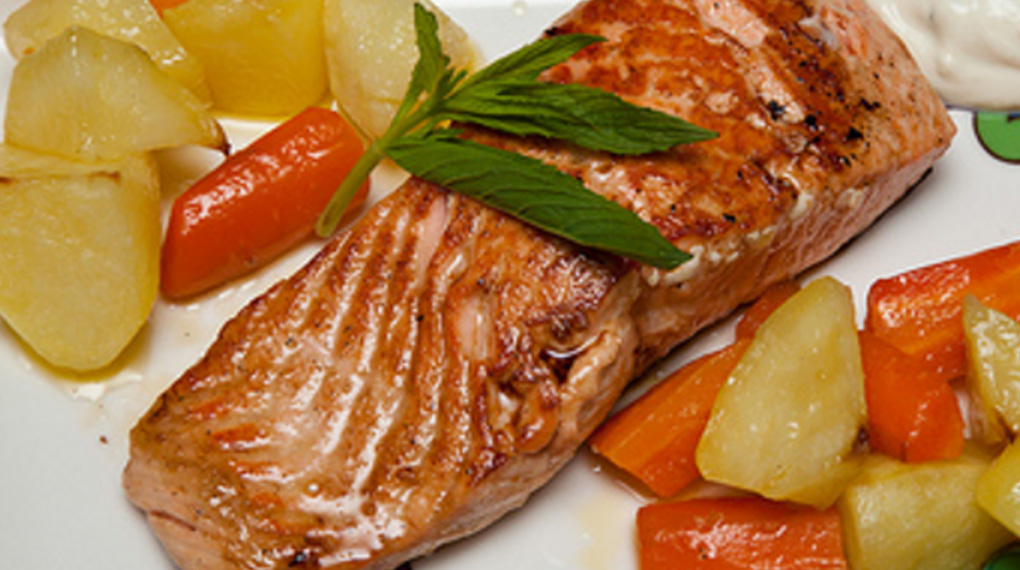
Salmon, a delicious and nutritious fish, has become increasingly popular worldwide. However, its growing demand raises concerns about the sustainability of its production and consumption. This section will delve into the environmental impact of salmon farming and wild-caught fishing, explore sustainable seafood certifications, and provide tips for making informed choices about salmon purchases.
Environmental Impact of Salmon Farming and Wild-Caught Fishing
Salmon farming and wild-caught fishing have distinct environmental impacts. Salmon farming, while providing a consistent supply, can have significant ecological consequences. These include:
- Habitat Degradation:Salmon farms often require the clearing of natural habitats, such as mangroves and seagrass beds, for their establishment. This habitat loss can negatively impact other marine species.
- Pollution:Salmon farms generate large amounts of waste, including uneaten feed, fish excrement, and antibiotics used to prevent disease. These pollutants can contaminate surrounding waters, harming marine life.
- Disease Outbreaks:The high density of fish in salmon farms can lead to disease outbreaks, requiring the use of antibiotics. These antibiotics can enter the surrounding ecosystem and contribute to the development of antibiotic-resistant bacteria.
- Escapees:Escaped farmed salmon can interbreed with wild salmon populations, potentially introducing diseases and reducing the genetic diversity of wild stocks.
Wild-caught salmon fishing, on the other hand, can have a significant impact on marine ecosystems if not managed sustainably. This can include:
- Overfishing:Excessive fishing pressure can deplete salmon populations, leading to ecological imbalances and a decline in the overall health of the marine ecosystem.
- Bycatch:Fishing gear can unintentionally capture other marine species, known as bycatch. This bycatch can include sea turtles, seabirds, and sharks, many of which are vulnerable or endangered.
- Habitat Disturbance:Bottom trawling, a fishing method used for catching some salmon species, can damage sensitive marine habitats, such as coral reefs and seafloor ecosystems.
Sustainable Seafood Certifications, Fit food spotlight salmon
To promote responsible salmon consumption, various organizations have developed sustainable seafood certifications. These certifications assess the environmental and social impacts of fishing and farming practices.
- Marine Stewardship Council (MSC):The MSC is a global non-profit organization that sets standards for sustainable wild-caught fisheries. It certifies fisheries that meet its rigorous standards for responsible fishing practices.
- Aquaculture Stewardship Council (ASC):The ASC is a non-profit organization that sets standards for responsible aquaculture practices. It certifies salmon farms that meet its criteria for environmental and social sustainability.
These certifications play a crucial role in ensuring that the salmon you consume is sourced from fisheries and farms that operate sustainably.
Making Informed Choices
When purchasing salmon, you can make informed choices that support sustainable practices:
- Look for Sustainable Seafood Certifications:Choose salmon that bears the MSC or ASC label. This indicates that the salmon was caught or farmed sustainably.
- Ask Your Fishmonger:If you’re unsure about the sustainability of the salmon you’re purchasing, ask your fishmonger about its source and whether it has been certified sustainable.
- Choose Locally Caught Salmon:Supporting local fisheries can help reduce the environmental impact of transporting salmon long distances.
- Consider Alternative Species:If salmon is not readily available or you’re concerned about its sustainability, consider other fish species that are certified sustainable, such as cod, pollock, or tilapia.
By making conscious choices about the salmon you consume, you can contribute to the health of our oceans and the long-term sustainability of this valuable resource.
Last Recap
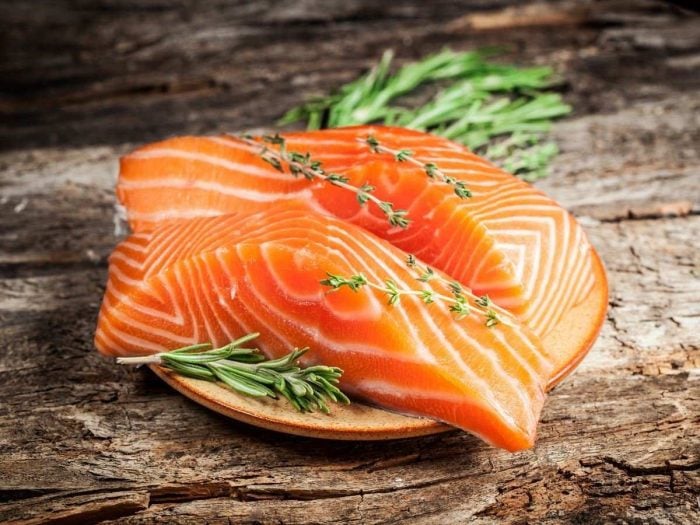
So, the next time you’re looking for a healthy and delicious meal, reach for salmon. Its versatility makes it a perfect fit for any diet, and its nutritional benefits will leave you feeling energized and satisfied. With a little knowledge and a few creative recipes, you can easily unlock the full potential of this incredible food.
Ready to embark on your salmon journey? Let’s dive in!

